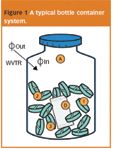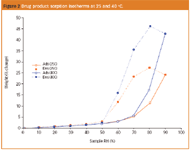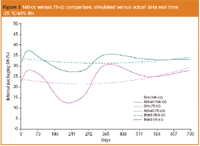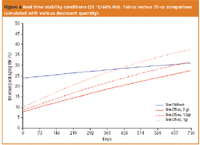The science behind sorbent selection
Pharmaceutical Technology Europe
Drug products subjected to degradation because of environmental stresses can be salvaged if proper packaging and protection is provided by sorbents.
Drug products subjected to degradation because of environmental stresses can be salvaged if proper packaging and protection is provided by sorbents. By the time the drug product is handed from the formulation chemists to the packaging engineers, mechanisms of degradation, such as hydrolysis, oxidation, dehydration, isomerization, racemization, elimination and photodegradation, are usually known. It is then up to the packaging engineers to plan a 'defence' against these degradation pathways.
In accordance with various regulatory guidelines, stability studies are required to prove that a drug will maintain its physical and chemical characteristics during a given time frame (expiration dating) to ensure the safety, identity, strength, quality and purity of the medicines. The International Conference on Harmonisation (ICH) has published a widely known guidance document regarding the outline of such stability studies.1
Whether dealing with a new drug application for innovators or an abbreviated new drug application (ANDA) for generics, time is money and quickly bringing a quality product to market is key. This is particularly true for generic companies filing ANDAs for reference listed drugs, as they are in competition for the 180-day exclusivity provisions set forth by the Hatch-Waxman Amendments to the Federal Food, Drug and Cosmetics Act.2
Many modern drug substances and products are susceptible to environmental humidity, and may physically or chemically degrade, or lose potency and efficacy when exposed to atmospheric moisture. Although higher barrier packaging can combat this issue, it is often cost-prohibitive compared with less expensive packaging solutions, such as high-density polyethylene (HDPE) bottles and incorporating sorbents.
Historically, basic calculations were made for products requiring a sorbent regarding sorbent selection for registration stability lots. A sorbent-ranging study was performed prior to this to determine whether or not the desiccant recommended and its quantity were correct. Performing these additional characterization tests, such as dissolution, assay and degradant monitoring, takes time and money.
Our goal was to eliminate sorbent-ranging studies or 'guesswork' by creating a predictive model of moisture permeation and adsorption to determine the appropriate sorbent and its amount to achieve shelf-life targets for given pharmaceutical formulations and dosage forms.
The scientific model
A pseudo-empirical modelling programme has been developed by Multisorb Technologies to mathematically predict the stability outcomes of testing. No model can truly replace empirical testing, but the programme decreases excessive testing, and demonstrates and predicts the effects of the selected packaging and its incorporated sorbents. The model predicts the internal conditions of a drug product package based on a given set of external conditions and selected input criteria. This modelling is based on the integration of internal and external equilibrium relative humidity (ERH) conditions with time, and the adsorption profiles/isotherms of the desiccant and drug product.
One of the assumptions necessary regarding the dynamics of permeation and adsorption was that, at any given time, the system inside a package is in a state of equilibrium: Φin=ERH1=ERH2=ERH3=ERHA=ERHD
Each component, i (i=D, 1, 2, 3,...) inside the bottle has its own sorption isotherm, Si(Φ) (Figure 1).

Figure 1: A typical bottle container system.
The water vapour transmission rate (WVTR) of the bottle is measured at some known humidity difference (ΔRH) between internal and external environments: ΔRH=Φin –Φout
A simplified picture of permeation and adsorption is considered:
- The RH outside the bottle is constant, as is the case with stability testing.
- Moisture permeation through container/package surface area is relatively slow, allowing for fairly rapid equilibration and an uniform ERH of all components.
- Quasi steady-state pattern of permeation through the bottle wall is present.
- Package WVTR is linearly scalable with ΔRH between separated environments, which is the case with many polymers including polyolefins.
The methodology follows a mass balance of moisture inside the bottle, including the moisture in the headspace air (typically minimal as can be calculated using psychrometric equations) and in each solid component such as drug product and sorbent. The model is isothermal with T(t)=constant. The sorption isotherms, Si(Φ), and density of saturated water vapour in air are obtained at a specific environmental temperature, T. The initial ERH of the package system is determined from the initial RH of all packaged components and atmospheric air at the time of package sealing. Through a series of mathematical operations and integrations, the time, t, to reach a given ERH, Φ, within the package is found. Consequently, the rate of water vapour ingress is controlled by the WVTR of the package material and the sorption capacity of the components within the packaging system. As the internal ERH of the bottle increases, the ΔRH between the inside of the package and the external conditions decreases, and the rate of moisture permeation through the package surface area decreases.
Water content versus water activity
Moisture can play a critical role in solid-state degradation. There are two kinds of water potentially present in a given drug product: bound water and 'free' or 'available' water.3 Bound water (i.e., water of crystallization) is an integral part of a molecule and may not be available for chemical activity. The energy of activation required to release this moisture is not usually achieved by solely lowering the RH or adding a desiccant. Unbound or 'free' water is loosely held by powder particles and available for chemical activity. The energy of activation required to release this moisture can be achieved by lowering the RH or adding a desiccant.
Water content is an extensive property of a given material. The quantitative measurement of water is typically performed by Karl Fischer titration, near-infrared spectroscopy or loss on drying (LOD). Karl Fischer titrations have dominated the measurement of water in pharmaceutical products for many years.4 "The Karl Fischer method measures surface moisture (unbound moisture) and most types of bound moisture. For some products, this means that the Karl Fischer method will measure more moisture than the gravimetric method."5
Water activity (aw) or ERH (aw×100 and expressed as a percentage) is derived from the fundamental principles of thermodynamics and physical chemistry. aw is an intensive property of a material and a qualitative measurement of the energy status of water in a system determined by equilibrating the liquid phase water in the sample with the vapour phase water in the headspace and measuring the RH of the headspace.3
Water content and aw can be correlated by analysing the adsorption/desorption isotherm of a material. Sorption isotherms delineate a substance's affinity for moisture at varying RH and temperature.
By determining the water content and water activity of a product and generating temperature-dependent sorption isotherms for all components in a package system, it is possible to model the internal conditions of the package system with time given constant external temperature and RH conditions. The entire package, including drug product and desiccant, acts as a complete system and will reach equilibrium with time. For packaging configurations that exclude desiccants, the moisture that ingresses through the bottle with time is adsorbed only by the drug product and evidenced by a higher ERH within the bottle during the stability testing time. For packaging configurations that include a desiccant, the desiccant will first adsorb moisture within the headspace (minimal). Because of the adsorption characteristics of the drug product versus the desiccant, the desiccant will adsorb moisture from the drug product. The drug product in proximity to the desiccant will desorb or transfer moisture in a shorter period of time than the drug product located further away from the desiccant. The moisture that ingresses through the bottle with time will be adsorbed by the drug product and desiccant according to their respective sorption isotherms.
Example
A pharmaceutical company asked for recommendations for a specific drug product that was experiencing degradation with time. In total, 30 tablets were examined. The drug product samples were representative of the physical and chemical characteristics as would be at the time of commercial packaging.
The company achieved acceptable stability results in one package configuration, but an undesired negative trend in another. Therefore, the goal of this evaluation was to provide supporting data for a desiccant recommendation for the one bottle that would most closely mirror that of the other bottle.
The tablets were weighed on a Model AG245 analytical balance (Mettler-Toledo, OH, USA) and an average weight of 260 mg was obtained with a relative standard deviation of 0.86%. Samples of the product were crushed in a mortar and pestle to obtain aw of the product at 25 °C and 40 °C using a Series 3TE Water Activity Meter (Decagon Devices Inc., WA, USA). The samples were allowed to equilibrate in the instrument for 15–17 min while continuous readings were taken and a constant value was obtained. Prior to testing, the instrument was calibrated using a LiCl 13.41 molal solution in water. The resultant values are listed in Table 1.

Table 1: Water activity measurements.
Accelerated stability testing and real time stability testing are generally performed per ICH-prescribed conditions of 40 °C /75% RH for 6 months and 25 °C/60% RH for the duration of the expiration date label claim (typically 2 years),1 respectively. Recognizing this, water vapour sorption testing of the drug product was performed at 25 °C and 40 °C. Using a symmetrical gravimetric analyser, the water vapour adsorption of the product was characterized from 10% to 90% RH in 10% increments. The water vapour desorption of the product was characterized from 90% to 10% RH in 10% increments. The equilibrium criteria were established such that the weight percent change of the tablet was <0.005% in 10 min or after a period of 300 min as maximum. These parameters defined the conditions necessary to progress from one RH step to the next. The data logging interval was every 2 min or a 0.200% change in weight.
For each experiment, one tablet was crushed with a mortar and pestle and the entire contents placed onto the weighing pan in the instrument. The samples were preconditioned within the instrument at their respective testing temperatures (40 °C or 25 °C) and <2% RH for a period of time to remove residual moisture and obtain a baseline of water vapour adsorption. The baseline is used to compare the drug product ERH with respect to residual moisture content. The moisture removed from the tablet during the preconditioning process is usually a good indication of how much moisture a desiccant could potentially remove.
Adsorption/desorption isotherms/profiles were generated at 40 °C and 25 °C. The sorption isotherms for the drug product are illustrated in Figure 2.

Figure 2: Drug product sorption isotherms at 25 and 40 °C.
The company provided drawings for the bottles utilized for commercial packaging: a 75-cc Blake bottle and a 160-cc wide-mouth Blake bottle. The HDPE resin used to produce the bottles is Marlex HHM 5502-BN, as manufactured by Chevron Phillips Chemical Company (TX, USA).
The quantity of tablets intended for commercial packaging was 350 in the 160-cc bottle and 30 in the 75-cc bottle. For the stability simulation models of the drug product, the following assumptions and principles applied:
- The water vapour permeability for the Marlex resin is 0.381 g×mL/(100 in2 ×day; nominal value at test conditions of 38 °C/90% RH), and 0.085 g×mL/(10 in2 ×day; nominal value at test conditions of 23 °C/60% RH).6
- The bottle dimensions and thickness obtained from the drawings were utilized to calculate the approximate surface areas of the bottle and corresponding moisture ingression, excluding the foil induction seal. The inside diameter of the mouth of the bottle and the base-to-shoulder height was utilized for ergonomics of the desiccant (i.e., ability to fit within the bottle).
- The reported bottle wall thickness is the minimum wall thickness at midpoint of the bottle. As there was no tolerance for thickness provided on the 160-cc bottle drawing, the worst case minimum value plus 0.25 mm was used in all calculations and simulations. For the 75-cc bottle, it was previously calculated and reported by the company that the average wall thickness was ;0.84 mm. It is noted that variations in the bottle wall thickness are inherent because of the molding process. Thicker portions of the bottle wall will have a lower WVTR than thinner portions and vice versa. WVTR of the whole sealed bottle can also be measured directly using Illinois Instruments' (IL, USA) series 7000 water vapour permeation analyser.
- The actual volume of space within the container that the drug product consumed was unknown. Because the moisture contribution to the system from the headspace of the container is minimal, the total volume in the container was estimated and utilized as void volume.
- The bottles maintain a foil-induction seal, and the simulations provided herein account for a steady-state moisture transmission through the bottle and do not account for poor seals, pinholes or thickness variations that could possibly occur in the molding or induction sealing process of the bottle.
- There are time constraints and limitations when performing isotherms on drug products in the finished tablet form. To compensate for the relatively short period of time a tablet will be subjected to given conditions within the gravimetric symmetrical analyser, as compared with extended periods of time in a container, the tablet was crushed prior to testing. This method increases surface area and accelerates the adsorption/desorption of the tablet. The reasoning behind this test is that, with extended periods of time (days/months), the moisture available to the tablet will eventually migrate and equilibrate throughout the entire tablet. The isotherms for the crushed tablets were used in all simulations.
- Fundamentally, as the adsorption isotherms did not display significant desorption moving from 0% to 10% RH, it was assumed that the drug product was sufficiently dried and a good baseline was established. Therefore, variations in moisture content of the drug product, assuming no chemical changes occurred, would only vary the initial equilibrium RH of the drug product, which was determined by evaluating the isotherm's X and Y axes. Slight variations in moisture content during formulation and/or processing of the drug product will alter the initial ERH slightly, but should not significantly affect the simulations as presented.
- The simulations account for steady-state conditions and equilibrium capacity of the drug product and desiccant. The 'initial RH of packaging system' is considered instantaneous. In actuality and not shown in the simulations, the ERH will gradually decrease and then increase with time to the reported 'initial RH of packaging system', similar to a cosine curve. For this reason, the simulations are less accurate during early stages of the testing, and do not account for the lag time in desorption/adsorption of the drug product and adsorption by the desiccant. This is especially true with real-time simulations as the kinetics of the system are slower than those at accelerated conditions. As time progresses and the system becomes more stable and change is more gradual, the predictions become more accurate.
The moisture removal that occurred during preconditioning/drying of the drug products within the instrument during the testing was ~1.15 and ~1.05% at 40 °C and 25 °C, respectively. This corresponded fairly well with the moisture content reported by the company (1.21% and 1.18%). Analysing the respective isotherms in Figure 2, moisture contents of 1.15% and 1.05% approximately equate to an ERH of 29–33%. The ERH is determined by first locating the initial moisture content of the product on the Y-axis of a graphical isotherm and then following the line perpendicular to the Y-axis until the said point crosses the isotherm line. The X-coordinate of this point is determined to be the ERH. Referring to the aw test results reported for crushed tablets in Table 1 of this report (0.298–0.337), the correlation is reasonable and within acceptable variation.
The company forwarded actual moisture content results from real-time stability testing of the drug product in 75-cc and 160-cc bottles. The water content measurements determined by LOD at given time points are presented in Table 2 (time in months).

Table 2: Actual drug product moisture content (real time stability testing).
As confirmed by the company, the time-point, t=0, was the 'initial' moisture content of the product at the start of stability testing and is not truly the 'release' moisture content of the drug product, as there was a delay between packaging and production of tablets. Also of importance is the fact that the t=0 data was that of the 75-cc bottle for both package configurations; a t=0 was not measured for the product in the 160-cc bottle.
Considering the aforementioned, the initial moisture content (i.e., the moisture content measured at initiation of stability testing) for the simulations of the 75-cc bottle was considered to be 0.80%. Analysing the actual moisture results on the previous page and considering the moisture content of the product, it follows reason that the 'initial' moisture content of the drug product packaged in the 160-cc bottle would be >0.80%. An average value of 1.13% was utilized for simulations pertaining to the 160-cc bottle configuration.
The 25 °C isotherm was used for real-time simulations and the 40 °C isotherm was utilized for accelerated simulations. Figure 3 displays the predicted ERH and corresponding drug product moisture content of the 350-count/160-cc bottle and 30-count/75-cc bottle, respectively, packaged with 2 g of silica gel (730 days real-time stability at 25 °C/60% RH). The actual moisture content data relayed by the company (Table 3) was converted to drug product ERH per the 25 °C isotherm and plotted on the graphs. A polynomial trend line was fitted to the data. As can be seen, the simulation's endpoint is very similar to the endpoint of the polynomial trend of the actual data.

Figure 3: 160-cc versus 75-cc comparison, simulated versus actual data real time -25 °C/60% RH.
Figure 4 displays the predicted ERH of the 30-count/75-cc bottle if packaged with 2 g, 1.5 g or 1 g of silica gel and tested at real-time conditions of 25 °C/60% RH for 730 days. The 160-cc bottle simulation (2-g silica gel) is also presented for comparison.

Figure 4: Real time stability conditions (25 °C/60% RH). 160-cc versus 75-cc comparison (simulated with various desiccant quantity).
Figure 5 displays the predicted ERH of the 30-count/75-cc bottle if packaged with 2 g, 1.5 g or 1 g of silica gel and tested at accelerated conditions of 40 °C/75% RH for 180 days. The 160-cc bottle simulation (2-g silica gel) is also presented for comparison.

Figure 5: Accelerated stability conditions (40 °C/75% RH). 160-cc versus 75-cc comparison (simulated with various desiccant quantity).
The ERH and corresponding drug product water content for all simulations and actual customer data have been summarized in Table 3.
Based upon the data provided by the company, and the testing and analyses, 1.5 g of silica gel was recommended for the 75-cc bottle configuration, such that the stability results would most closely reflect those established with the 160-cc bottle configuration with 2 g of silica gel.

Table 3: Summary of simulations and customer data.
Conclusions
It can be seen from the example provided previously that our modelling programme is valid and effective in predicting the moisture content of drug products with time. With basic knowledge of the formulations and pathways of degradation, the stability outcome of formulations can be determined.
The example provided details a HDPE bottle package configuration, but the model can be used with other package designs, such as blisters, pouches, intermediate bulk containers and inhalation devices. The base requirements for use of the model are sorption isotherms, a known WVTR at constant internal and external RH, and some basic knowledge of the formulations and pathways of degradation.

On the go...
Thomas J. Hurley is a Senior Product Leader for Healthcare Packaging at Multisorb Technologies (NY, USA). He has worked at Multisorb for 8 years providing technical support and consultations to the company's global healthcare customers. His involvement within the R&D team has allowed him to provide new and innovative solutions for customers' packaging needs. Prior to joining Multisorb, he was a Production Manager at The Mentholatum Company (NY, USA) and Operations Supervisor at Kraft Foods (IL, USA). He holds a BSc in Chemistry from Clarkson University (NY, USA).
Stanislav E. Solovyov is a Principal Scientist at Multisorb Technologies (NY, USA). His industrial experience lies in polymer manufacturing, processing, and process and performance property modelling in packaging applications. His research interests include active packaging technology, nonlinear dynamics of dissipative chemical systems, physical chemistry of polymers, rheology and processing of polymer melts and composites, powder processing, design and performance modelling of reactive barrier packaging. He is the author of 20 peer-reviewed articles in scientific journals and six US patent applications. He holds BSc and MS degrees in Applied Mathematics and PhD degree in Polymer Chemistry with postdoctoral experience in Chemical Reaction Engineering and Materials Engineering and Science.
References
1. CDER/FDA Guidance for Industry — Q1A (R2) Stability Testing of New Drug Substances and Products, November 2003. www.fda.gov/cder
2. CDER/FDA Guidance For Industry — 180 day Generic Drug Exclusivity Under the Hatch-Waxman Amendments to the Federal Food, Drug, and Cosmetics Act, June 1998. www.fda.gov/cder
3. A.J. Fontana, Fundamentals of Water Activity Part I: Water Activity, Decagon Devices, Inc., 16 April 2008. www.on24.com
4. B. Snider, L. Peihong and N. Pearson, Pharm. Technol. 31(2) 56–71 (2007).
5. Centre for Biologics Evaluation and Research — Guideline for the Determination of Residual Moisture in Dried Biological Products, January 1990. www.biopharm.com.tw
6. Actual testing provided by Chevron Phillips Chemical Co. (TX, USA), September 2005.
Drug Solutions Podcast: A Closer Look at mRNA in Oncology and Vaccines
April 30th 2024In this episode fo the Drug Solutions Podcast, etherna’s vice-president of Technology and Innovation, Stefaan De Koker, discusses the merits and challenges of using mRNA as the foundation for therapeutics in oncology as well as for vaccines.
